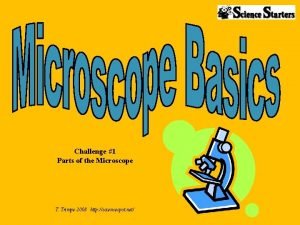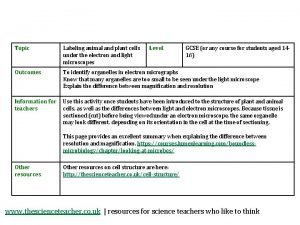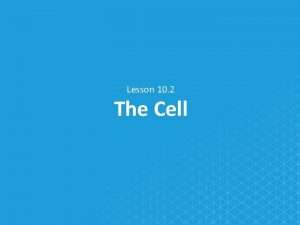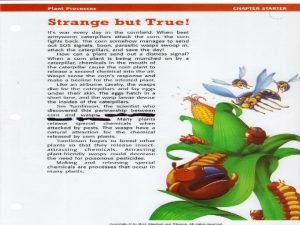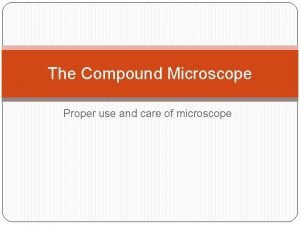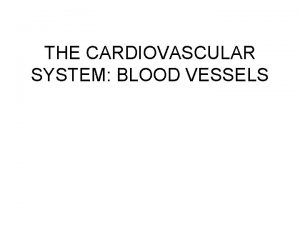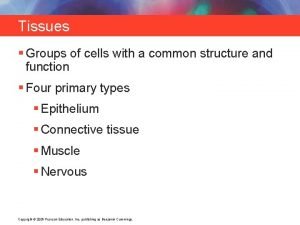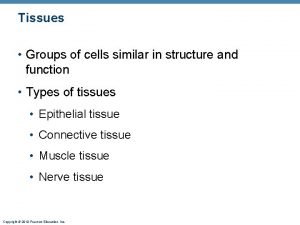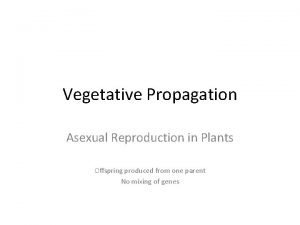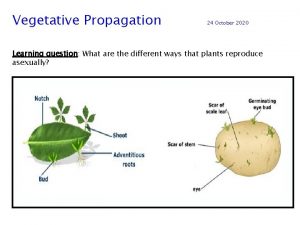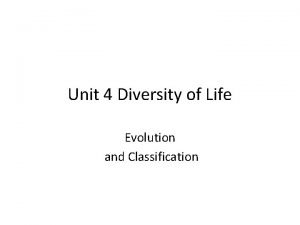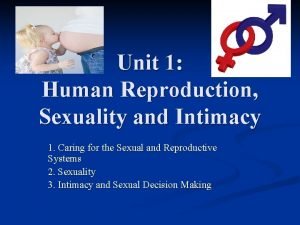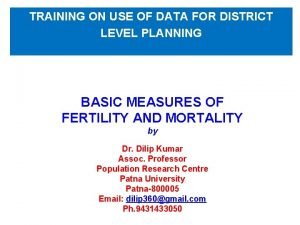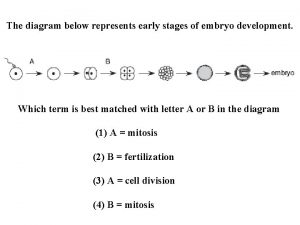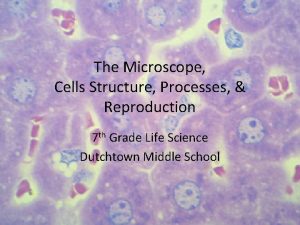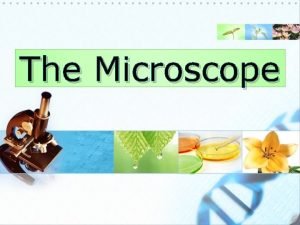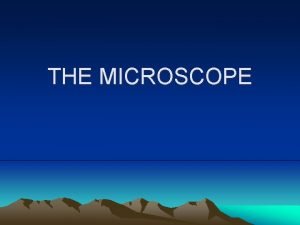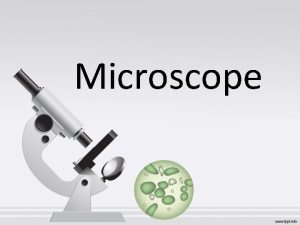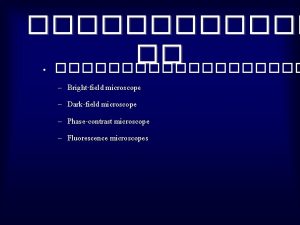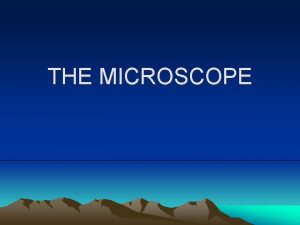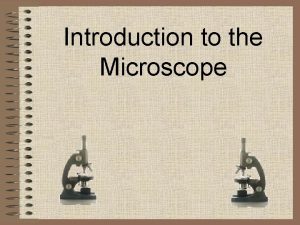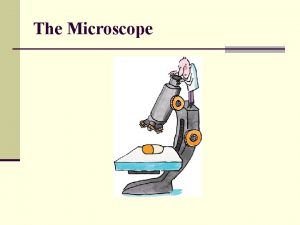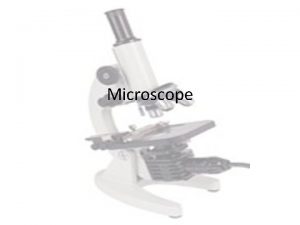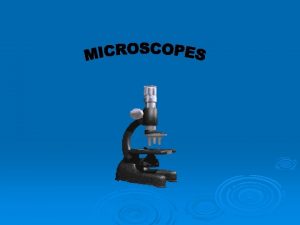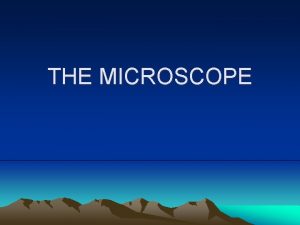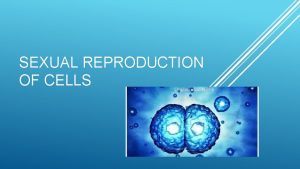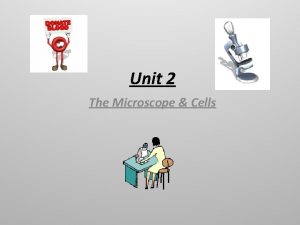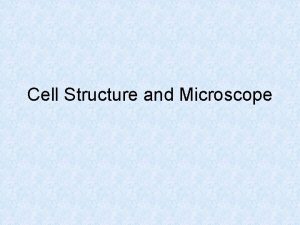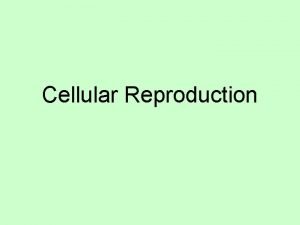The Microscope Cells Structure Processes Reproduction 7 th




















































































- Slides: 84

The Microscope, Cells Structure, Processes, & Reproduction 7 th Grade Life Science Dutchtown Middle School

S 7 L 2 Students will describe the structure and function of cells, tissues, and organ system. a. Explain that cells take in nutrients in order to grow and divide and to make need materials. b. Relate cell structures (cell membrane, nucleus, cytoplasm, chloroplasts, mitochondria) to basic cell functions.

The Microscope

The Microscope http: //www. youtube. com/watch? v=Ue-86 MDmjns Microscope: The Tube that Changed the World • Between 1590 and 1600 several scientist had their hand in creating what we know call the microscope. • They found that by putting curved pieces of glass – called lenses – in a tube, they could make a microscope. • Early microscopes-lenses made images larger, but not always clear.

The Microscope 1. Modern microscopes that use lenses to bend light. a. A simple microscope has one lens while a compound microscope has two sets of lenses. b. A stereomicroscope has two eyepieces, and creates a three-dimensional image. c. Powers of the eyepiece multiplied by objective lenses determine total magnification.

The Microscope 2. Electron microscopes are more powerful than other microscopes. a. Use a magnetic field in a vacuum to ben electronic beams. b. Images must be photographed or produced electronically.

Question What are some differences between electron microscopes and other microscopes? • Lenses or magnetic fields • Viewing of the image • Magnification

Robert Hooke The Wacky History of Cell Theory http: //www. youtube. com/watch? v=4 Op. Bylw. H 9 DU • In 1665, Robert Hooke, used a microscope to look at thin slices of a plant material called cork. • Robert Hooke identified tiny box-like structures. He named these structures cells. • Over the years, scientist used microscopes to observe countless living and nonliving materials. • They discovered that all living things are made of cells, while non-living things are not.

Development of Cell Theory The cell theory resulted from many scientist observations and conclusions. Cell Theory 1. The basic unit of organization is the cell. 2. All organisms are composed of one or more cells. 3. New cells come from old cell through cell division.

Cell Structure

Cell Structures Vocabulary Mitochondria Organelle Cell Wall Cell Membrane Cytoplasm Chloroplast Endoplasmic Reticulum Vacuole Prokaryote Eukaryote Nucleus Organization of Life Cell Tissue Organ System Organism

Cell Structure 1. Cells are the smallest units of living things. 2. Cells are known as the tiny building blocks of life. 3. Common cell structures – outer covering called cell membrane and internal gelatin like cytoplasm a. Comparing cells – size and shape relate to function.

Cell Structure 4. There are two types of cells: a. Prokaryotic cells lack membrane-bound internal structures. b. Eukaryotic cells contain membrane-bound internal structures.

Prokaryotic & Eukaryotic Cell http: //www. usatestprep. com/movies/119/519/3258/159? key=UTXM 7 QH 36 DQ All Cells Membrane Genetic Material Cytoplasm (viscous – thick) Prokaryotic • • Primitive & Small Lack Organelles/No Nucleus Ribosomes May have Chlorophyll Genetic Material Eubacteria/Archeabacteria Autotrophs Eukaryotic True Cell All Organelles – Nucleus Organized More Complex Genetic Material DNA/RNA found in the Nucleus • Chlorophyll found in Chloroplast • Autotrophs and Heterotrophs • • •

Cell Organization Cell Wall Composed of cellulose, a cell wall grows, gives shape to, and protects the cells of plants, algae, fungi, and most bacteria.

Cell Organization Cell Membrane The protective layer around all cells. a. For cells with cell walls, the cell membrane is inside the cell wall. b. A cell membrane allows food and oxygen into the cell and waste products out of the cell.

Cell Organization Cytoplasm Gelatin like substance inside the cell membrane. 1. Cytoskeleton is the scaffolding like structure in cytoplasm which helps cell keep its shape. 2. In the cytoplasm, eukaryotic cells have organelles which help with cell life processes.

Cell Organization Nucleus The nucleus contains instructions for everything the cell does. DNA is also found within the nucleus.

Cell Organization Energy-processing Organelles Energy-processing organelles help cells do their work. a. Green organelles in plant cells contain chloroplasts to make food. b. Organelles which release energy from food are called mitochondria.

Cell Organization Manufacturing Organelles a. Ribosomes make proteins for cell activities. b. Some ribosomes attach to the rough endoplasmic reticulum, which is a series of smooth or rough membranes that move material around in a cell.

Cell Organization Transporting and Storing Organelles a. Golgi bodies move substances out of a cell or to other parts of a cell. b. Vacuoles – membrane bound temporary storage spaces of water, nutrients, & waste.

Cell Organization Recycling Organelles Lysosomes break down food molecules and cell waste.

Review of Cell Organelles • Cell Wall – gives added support and protection • Cell Membrane – surrounds the cytoplasm and protects the cell. • Cytoplasm – jelly-like substance that fills the cell. • Nucleus – Controls activities of the cell. • Chloroplasts – produce food • Mitochondria – provide energy • Vacuole – stores water, food, and wastes • Lysosomes – break down food molecules & cell waste

Review of Cell Organelles • Ribosome – protein is made on this organelle • Golgi bodies – sort protein and other cellular substances and deliver to vesicles. • Endoplasmic Reticulum (ER) – a series of folded membranes in which materials can be processed and moved around inside of the cell.

Plant Cell Organelles • • • Cell Wall Cell Membrane Cytoplasm Nucleus/Nucleolus Chloroplasts Mitochondria Vacuole Endoplasmic Reticulum (ER) Ribosome Golgi bodies

Animal Cell Organelles • • • Cell Membrane Cytoplasm Cytoskeleton Nucleus/Nucleolus Mitochondria Ribosome Lysosome Vacuole Endoplasmic reticulum Golgi bodies

Cells & Their Functions Every cell carries out basic life jobs or functions. • All cells use energy. • All cells get rid of wastes. • All cells can reproduce. They do this by dividing. • Most living things are tiny organisms made of one cell. (Unicellular) • Larger organisms, plants & animals, are made of many cells.

From Cell to Organism 1. Tissue – group of similar cells working together on one job. 2. Different types of tissues working together make up an organ. 3. A group of organs working together on a particular function form an organ system.

Cells are the building blocks of life… • In a multi-celled organism, different cells do different jobs. – A group of similar cells working together to do a job make up TISSUE. – A group of different tissues working together are an ORGAN. – A group of organs working together make up an organ system.

Levels of Cellular Organization Cell Heart Cell Tissue Heart Tissue Organ Heart Organ System Circulatory System

Level of Cell Organization

Question What are some functions of cell parts? • • Protection Providing shape Processing energy Making, transporting, and storing substances

Big Ideas • Cells take in nutrients to grow and divide and make needed materials. • Cell structure is related to cell function • Cells are interdependent. • The levels of cellular organization: Cells Tissue organs systems organism

Cell Processes

S 7 L 2 Students will describe the structure and function of cells, tissues, and organ system a. Explain that cells are organized into tissues, tissues into organs, organs into systems, and systems into organisms. b. Explain that tissues, organs, and organ systems serve the needs cells have for oxygen, food, and waste removal. c. Explain the purpose of the major organ systems in the human body (i. e. digestion, respiration, reproduction, circulation, excretion, movement, control, and coordination, and for protection from disease. )

Matter & Energy • Everything around you is made up of matter and energy. • Matter is anything that has mass and takes up space. • Energy can hold matter together or break it apart.

Organic Compounds Organic compounds contain carbon and hydrogen and are usually associated with living things or things that once were alive.

Organic Compounds Four groups of organic compounds make up all living things: 1. Carbohydrates - supply energy for cell processes 2. Lipids - store and release large amounts of energy. 3. Proteins – are the building blocks of many structures. 1. Amino Acids – make up protiens 2. Enzymes – regulate nearly all chemical reactions in cells 4. Nucleic Acids- store important coded information in cell

Inorganic Compounds Usually made from elements other than carbon. Water is an inorganic compound.

Inorganic Compounds The Importance of Water 1. Living things are composed of more than 50 percent water and depend on it to survive. 2. All chemical reactions in living things take place in water solutions. 3. Most living things use water to transport materials through their bodies.

Cell Composition Cell’s Composition Cells are 90% water (Inorganic Compound). Water makes up most of blood; most chemical reactions occur in water. The rest of the present molecules are: (Organic Compounds Found in Living Things) • 50% protein • 15% carbohydrate • 15% nucleic acid • 10% lipid • 10% others Elements That Make Up the Human Body By elements, a cell’s composition by mass is: • 10% Hydrogen • 63% Oxygen • 20% Carbon • 3% Nitrogen • 4% Other trace elements such as iron, calcium, etc.

Question What are you made of? Organic compounds, including carbohydrates, lipids, proteins, and nucleic acids. Inorganic compounds like water.

Essential Questions • How do you explain the relationship between the structures and functions of cell organelles? • Why is each part of the cell essential to survival? • How is a living organism the sum of all of its parts? • Why must cells absorb energy and nutrients? • How do cells, tissues, organs, and organ systems relate to the complexity of living organisms? • How does scientific development rely on our knowledge of cells? • What happens when cells cease to function adequately or at all? • Can plant and animal cells function without sunlight? Explain. • What do cells tell us about basic processes of life…life, death, and reproduction? • How are cells like building blocks?

Moving Cellular Materials

Cell Processes Vocabulary Osmosis Diffusion Active Transport Passive Transport Equilibrium Endocytosis Exocytosis Metabolism Photosynthesis Cellular Respiration

Moving Cellular Materials Cells have a selectively permeable membrane that regulates what goes into or out of the cell.

Cell Membrane • The permeable membrane allows the molecules to pass through. An impermeable membrane doesn’t allow anything to pass. Only some molecules can pass through a semipermeable membrane – usually only small molecules pass through quickly.

Passive Transport Passive transport is the movement of substances through the cell membrane without the input of energy. There are 3 types of passive transport: diffusion, osmosis, and facilitated diffusion. 1. Diffusion is the random movement of molecules from areas where there is a high concentration to areas where there a low concentration. (Example: Scent of perfume, food color lab) Likewise, equilibrium occurs when the molecules of are spread evenly throughout another substance. (Example: Carrot sticks lab, carrots are crisp) 2. Osmosis is the diffusion of water through a cell membrane. (Example: gummy bear lab) 3. Facilitated diffusion, transport proteins move substances into and out of the cell.

Active Transport Cells use/require energy to move molecules by active transport Cells move large or bulky particles through cell membranes by endocytosis and exocytosis. Endocytosis is the process in which a substance is taken into a cell by surrounding it with the cell membrane, forming a sphere called a vesicle. Exocytosis is the process in which the membrane of the vesicle fuses with the cell membrane and the vesicle’s contents are released outside the cell.

Question What needs to be transported through your cells’ membranes? Transported in the cell: • Nutrients from food • Oxygen • Water Transported out of the cell: • Wastes • Carbon dioxide

Essential Questions • How do cells, tissues, organs, and organ systems relate to one another? • How the functions of organ systems interact? • How do tissues, organs, and organ systems serve cells needs for oxygen, food, and waste removal? • How do the higher levels of organization serve the needs of cells? • How do the systems compare in different organisms? • How does the hierarch of organisms result in the complexity and diversity of organisms? • How does reproduction vary among organisms?

How do living things get energy? Metabolism is the total of all chemical reactions in an organism. The chemical reactions of metabolism require enzymes. Cells use chemical reactions to change the chemical energy stored in food into forms need to perform activities.

How do living things get energy? Photosynthesis is the process that plants and other organisms use to convert light energy into chemical energy or sugars to be used as food. Producers are organisms that make their own food. Consumers are organisms that can’t make their own food. Chlorophyll and other pigments are used in photosynthesis to capture light energy which is used to produce sugar and oxygen.

How do living things get energy? Cellular Respiration Cellular respiration is the process in which chemical reactions break down food molecules into simpler substances and release stored energy.

How do living things get energy? Cellular Respiration Cellular respiration of carbohydrates begins in the cytoplasm. a. Carbohydrates are broken down into glucose molecules. b. Each glucose molecule is broken down into two simpler molecules releasing energy.

How do living things get energy? Cellular Respiration Cellular respiration moves into the mitochondria. a. The two simpler molecules are broken down again, releasing much more energy. b. This process uses oxygen and produces carbon dioxide and water as wastes.

How do living things get energy? Fermentation Cells that do not have enough oxygen for cellular respiration use this process t release some of the stored energy in glucose molecules. 1. Entire process occurs in the cytoplasm. 2. Produces lactic acid, alchol, and carbon dioxide waste.

Almost opposite of each other… Photosynthesis Produces sugars and oxygen, which are used in cellular respiration. Cellular Respiration Produces carbon dioxide and water which are used in photosynthesis.

Question • Water to transport You are about to go for a nutrients to the cells. run. What does your body • Carbohydrates or lipids need to make the energy as a source of chemical you will use? energy. • Enzymes to assist the chemical reactions. • Oxygen to fuel respiration.

Cell Reproduction

S 7 L 2 Students will describe the structure and function of cells, tissues, and organ system. Vocabulary Cell Reproduction Mitosis Meiosis Sexual Reproduction Asexual Reproduction Haploid Diploid Cycle Chromosome Fertilization Egg Sperm

Cell Division and Mitosis Cell division – increases the number of cells and causes multi-cellular organisms to grow. The Cell Cycle – series of events that takes place from one cell division to the next.

Cell Division and Mitosis Cell Division Increases the number of cells and causes multicellular organisms to grow.

The Cell Cycle Series of events that takes place from one celldivision to the next

Life Cycle of a Cells have periods of formation, growth and development, and death.

Cell Division: Interphase Most of the life of any eukaryotic cell, or cell with a nucleus, is spent in a period of growth and development. a. During interphase, a cell duplicates its chromosomes and prepares for cell division. b. After interphase, the nucleus divides, and then the cytoplasm separates to form new cells.

Mitosis Process in which the nucleus divides to form two identical nuclei.

Prophase a. Nucleolus and nuclear membrane disintegrate b. Centrioles move to opposite ends of the cell. c. Spindle fibers begin to stretch across the cell.

Metaphase • Pairs of chromatids line up across the center of the cell.

Anaphase • Each centromere divides. • Each pair of chromatids seperate and moves to opposite ends of the cell.

Telophase • Spindle fibers disappear and a new nucleus forms.

Division of Cytoplasm For most cells, the cytoplasm separates after the nucleus divides. 1. In animal cells, the cell membrane pinches in the middle and the cytoplasm divides. 2. In plant cells, a cell plate forms.

Results of Mitosis 1. Each cell in your body, except sex cells, has a nucleus with 46 chromosomes. 2. Allows growth and replaces worn out or damaged cells.

Asexual Reproduction 1. A new organism is produced from one parent organism. 1. Budding – a small, exact copy of the adult grows from the body of the parent. 2. Regeneration, a whole new organism grows from each piece of the parent. 3. Fission -

Question Why is cell division important? We wouldn’t be able to grow or heal by replacing worn-out and damaged cells without cell division.

Sexual Reproduction and Meiosis Sexual reproduction consist of two cells, usually an egg and sperm cell, also called gametes. They come together through fertilization.

Sexual Reproduction: Fertilization is the joining of an egg and a sperm, generally from two different organisms of the same species.

Sexual Reproduction: Fertilization Sperm are formed in the male reproductive organs. Eggs are formed in the female reproductive organs. A cell that forms from fertilization is a zygote.

Sexual Reproduction: Fertilization Following fertilization, cell division begins and a new organism develops.

Sexual Reproduction Your body forms two types of cell: 1. Diploid Cells – Body cell, 46 chromosomes (far out number sex cells due to brain, skin, bones, etc) 2. Haploid Cells – Sex Cells, 23 chromosomes Human body cells are diploid because they have 23 pairs of similar chromosomes. Human sex cells are haploid because they have 23 single chromosomes.

Meiosis is a process that produces haploid sex cells and ensures that offspring have the same diploid number as its parent. There two stages of Meiosis: Meiosis I & Meiosis II.

Meiosis I In meiosis I, the nucleus divides and produces two new cells with one duplicated chromosome each.

Meiosis II In Meiosis II, the nuclei divide and the chromatids separate, producing four cells with half the number of chromosomes of the original nucleus.

Question Why do you think sex cells must be haploid? A sex cell has 23 single chromosomes, so that when it joins another sex cell, the two sets of single chromosomes can pair up and produce an organism with 46 chromosomes and unique traits.
 Nondisjunction in meiosis
Nondisjunction in meiosis Asexual reproduction cell division
Asexual reproduction cell division Hare lynx
Hare lynx Sexual vs asexual reproduction venn diagram
Sexual vs asexual reproduction venn diagram Concurrent processes are processes that
Concurrent processes are processes that Light microscope vs electron microscope
Light microscope vs electron microscope Microscope mania compound light microscope
Microscope mania compound light microscope Animal cells under microscope
Animal cells under microscope Pearson
Pearson Rosa uses a microscope to look at a group of cells
Rosa uses a microscope to look at a group of cells Olfactory groove keros classification
Olfactory groove keros classification Transport maximum
Transport maximum Thyroid gland
Thyroid gland Haploid and diploid venn diagram
Haploid and diploid venn diagram Somatic cells vs germ cells
Somatic cells vs germ cells Chlorocruorin
Chlorocruorin Prokaryotic cell vs eukaryotic cell
Prokaryotic cell vs eukaryotic cell Plant vs animal cell venn diagram
Plant vs animal cell venn diagram Prokaryotic vs eukaryotic cells venn diagram
Prokaryotic vs eukaryotic cells venn diagram Cell organelle jeopardy
Cell organelle jeopardy Masses of cells form and steal nutrients from healthy cells
Masses of cells form and steal nutrients from healthy cells Label
Label What animals have prokaryotic cells
What animals have prokaryotic cells Are red blood cells prokaryotic or eukaryotic
Are red blood cells prokaryotic or eukaryotic Cells and life lesson 1 answer key
Cells and life lesson 1 answer key Embryo in flower
Embryo in flower Body tube microscope
Body tube microscope Animal cell under microscope
Animal cell under microscope Hát kết hợp bộ gõ cơ thể
Hát kết hợp bộ gõ cơ thể Lp html
Lp html Bổ thể
Bổ thể Tỉ lệ cơ thể trẻ em
Tỉ lệ cơ thể trẻ em Chó sói
Chó sói Chụp tư thế worms-breton
Chụp tư thế worms-breton Alleluia hat len nguoi oi
Alleluia hat len nguoi oi Các môn thể thao bắt đầu bằng tiếng bóng
Các môn thể thao bắt đầu bằng tiếng bóng Thế nào là hệ số cao nhất
Thế nào là hệ số cao nhất Các châu lục và đại dương trên thế giới
Các châu lục và đại dương trên thế giới Cong thức tính động năng
Cong thức tính động năng Trời xanh đây là của chúng ta thể thơ
Trời xanh đây là của chúng ta thể thơ Mật thư tọa độ 5x5
Mật thư tọa độ 5x5 Làm thế nào để 102-1=99
Làm thế nào để 102-1=99 độ dài liên kết
độ dài liên kết Các châu lục và đại dương trên thế giới
Các châu lục và đại dương trên thế giới Thơ thất ngôn tứ tuyệt đường luật
Thơ thất ngôn tứ tuyệt đường luật Quá trình desamine hóa có thể tạo ra
Quá trình desamine hóa có thể tạo ra Một số thể thơ truyền thống
Một số thể thơ truyền thống Cái miệng nó xinh thế
Cái miệng nó xinh thế Vẽ hình chiếu vuông góc của vật thể sau
Vẽ hình chiếu vuông góc của vật thể sau Biện pháp chống mỏi cơ
Biện pháp chống mỏi cơ đặc điểm cơ thể của người tối cổ
đặc điểm cơ thể của người tối cổ Ví dụ về giọng cùng tên
Ví dụ về giọng cùng tên Vẽ hình chiếu đứng bằng cạnh của vật thể
Vẽ hình chiếu đứng bằng cạnh của vật thể Tia chieu sa te
Tia chieu sa te Thẻ vin
Thẻ vin đại từ thay thế
đại từ thay thế điện thế nghỉ
điện thế nghỉ Tư thế ngồi viết
Tư thế ngồi viết Diễn thế sinh thái là
Diễn thế sinh thái là Dot
Dot Số nguyên tố là
Số nguyên tố là Tư thế ngồi viết
Tư thế ngồi viết Lời thề hippocrates
Lời thề hippocrates Thiếu nhi thế giới liên hoan
Thiếu nhi thế giới liên hoan ưu thế lai là gì
ưu thế lai là gì Hổ đẻ mỗi lứa mấy con
Hổ đẻ mỗi lứa mấy con Khi nào hổ mẹ dạy hổ con săn mồi
Khi nào hổ mẹ dạy hổ con săn mồi Hệ hô hấp
Hệ hô hấp Từ ngữ thể hiện lòng nhân hậu
Từ ngữ thể hiện lòng nhân hậu Thế nào là mạng điện lắp đặt kiểu nổi
Thế nào là mạng điện lắp đặt kiểu nổi Blood
Blood Muscle tissue parts
Muscle tissue parts A group of cells similar in structure and function
A group of cells similar in structure and function Tissues are groups of similar cells working together to:
Tissues are groups of similar cells working together to: A saclike structure in which cells store materials
A saclike structure in which cells store materials Vegetative propagation
Vegetative propagation Vegetative propagation examples
Vegetative propagation examples Vampire squid fun facts
Vampire squid fun facts Geographic isolation examples
Geographic isolation examples Reproduction in humans
Reproduction in humans Fission vs budding
Fission vs budding Fertility rate formula
Fertility rate formula Platyhelminthes vs nematoda
Platyhelminthes vs nematoda The diagram below shows stages of human reproduction
The diagram below shows stages of human reproduction What do sun bears eat
What do sun bears eat






